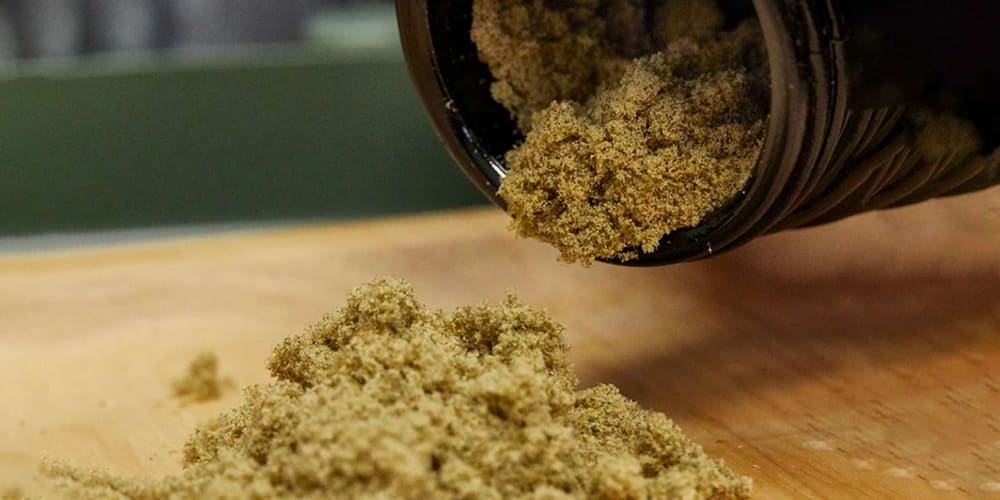
Weed Education
How to Decarb Kief: A Detailed Guide

Decarb kief, a term that resonates with many in the cannabis industry, is a crucial step in enhancing the potency and flavor of cannabis products. This process, which involves applying heat to cannabis trichomes, transforms the non-psychoactive THCA into the psychoactive THC, unlocking the full potential of cannabis. This article delves into the science, methodology, and benefits of decarboxylating kief, providing an insightful guide for both enthusiasts and professionals.
Understanding Decarboxylation

Decarboxylation is fundamentally a chemical reaction, essential in the process to decarb kief. Kief, comprising crystalline trichomes from the cannabis plant, contains cannabinoids in their acidic forms, such as THCA and CBDA. These forms, while cannabinoid-rich, do not possess psychoactive properties in their raw state, necessitating the decarboxylation process to activate their full potential.
The process to decarb kief involves applying heat. This heat initiates a chemical reaction where a carbon atom is released from the cannabinoid’s molecular chain. This reaction is crucial as it transforms the cannabinoids from their acidic form into a state that exhibits psychoactive effects, a necessary step for their effective use in various cannabis products.
Transforming THCA into THC is the primary goal of decarbing kief. The heat-induced reaction effectively converts THCA, a non-psychoactive compound, into THC, the compound renowned for its psychoactive effects. This conversion is key to unlocking the full potential of kief, transforming it from a simple collection of trichomes into a potent ingredient suitable for various applications in cannabis consumption and products.
Experience the exhilarating Chunky Monkey infused mini joints with kief. With 18% THC, it offers happiness, relaxation, and a euphoric feel, complemented by exotic fruit, earthy, and diesel aromas.
The Importance of Decarboxylating Kief

The purpose of decarb kief extends beyond merely activating THC. This process plays a crucial role in enhancing the overall flavor profile of cannabis. By applying heat, terpenes – the compounds responsible for the plant’s distinctive aroma and taste – are released. This enhancement of the sensory qualities makes decarbed kief a sought-after ingredient for those who appreciate the finer nuances of cannabis flavors and aromas.
In addition to flavor enhancement, the process to decarb kief is particularly important for medicinal cannabis users. Decarboxylation ensures that the full therapeutic potential of the cannabinoids is activated. For patients relying on cannabis for relief, this means accessing the maximum benefits that these compounds can offer, making decarboxylation a vital step in medicinal cannabis preparation.
Therefore, decarb kief is not just a step for those seeking the psychoactive effects of THC. It’s a comprehensive process that augments the overall quality of the cannabis experience, whether for recreational enjoyment or medicinal purposes. By transforming kief through decarboxylation, users can experience the full spectrum of benefits that cannabis has to offer, from enhanced flavors to increased therapeutic efficacy.
Step-by-Step Guide to Decarboxylating Kief

The process of decarboxylating kief is relatively simple and can be done at home with basic kitchen equipment.
- Preparation: Begin by evenly spreading the kief on a baking sheet. The layer should be thin to ensure uniform heat distribution.
- Oven Settings: Preheat your oven to a temperature between 220°F and 240°F. This range is optimal for decarboxylation, as higher temperatures might degrade the cannabinoids and terpenes.
- Baking Time: Place the baking sheet in the oven and bake the kief for about 30 to 40 minutes. It’s important to stir the kief occasionally to ensure even exposure to heat.
- Cooling Down: After removing the kief from the oven, let it cool at room temperature. This helps preserve the potency and flavor.
Indulge in Wedding Cake Prerolls Hash Rosin Infused and kief for a superb experience. Enjoy its earthy, sweet, and fruity flavors, with a vanilla-spiced aroma, providing cerebral uplift and body relaxation.
Tips for Perfect Decarboxylation

- Even Spreading: It’s crucial to spread the kief evenly across the baking sheet. This helps to avoid uneven decarboxylation, ensuring that all parts of the kief are equally exposed to heat.
- Temperature Accuracy: Accurately gauging the oven’s temperature is key. Use an oven thermometer to verify the actual temperature, as ovens can sometimes be off, leading to inconsistent decarboxylation.
- Stirring: Regular stirring of the kief during the process is important to prevent any potential burning. This practice ensures even heating and decarboxylation across the entire batch of kief.
The Role of Decarb Kief in Edibles

In the realm of cannabis edibles, the process to decarb kief is a crucial step that significantly influences the final product’s potency and effects. The inclusion of decarb kief in edibles recipes is key to ensuring that the edibles not only possess the desired strength but also deliver the anticipated psychoactive effects. This process activates the THC in kief, which is essential for achieving the full potential of cannabis-infused edibles.
When making edibles without decarb kief, the end product might not meet expectations in terms of its psychoactive properties. This is because THCA, the non-decarboxylated form of THC, does not induce the same effects as its activated counterpart, THC. Therefore, skipping the decarb process can result in edibles that are less effective, lacking the characteristic impact that consumers typically seek from cannabis-infused products.
Thus, decarb kief is not just a mere step in the preparation of cannabis edibles, it is a transformative process that ensures the edibles are effective and consistent in their potency. By converting THCA into THC, decarbing kief guarantees that the psychoactive elements are fully available, making it a fundamental technique for anyone looking to create high-quality, potent cannabis edibles. This process highlights the importance of understanding and applying proper techniques in the preparation of cannabis-infused culinary creations.
Discover the unique journey of Paradise Cream infused mini joints coated in kief. This indica strain starts with an energetic boost, then gently eases you into relaxation, possibly awakening your appetite towards the end.
The Benefits of Decarboxylating Kief

Decarboxylating kief is a transformative process with multiple benefits, going beyond just altering the chemical composition of cannabinoids. It enhances the overall quality and effectiveness of the kief, making it a more versatile and potent ingredient for various cannabis products. The process of decarboxylation activates the full potential of the cannabinoids, leading to a more pronounced and effective result when consumed.
- Increased Potency: By converting THCA to THC, decarboxylated kief becomes significantly more potent, providing a stronger and more pronounced effect. This increase in potency makes it an ideal choice for those seeking a more impactful cannabis experience.
- Versatility: Decarboxylated kief can be utilized in a multitude of ways, broadening its applications. It is a valuable ingredient in edibles, where it enhances potency, in tinctures for easy consumption, and in topicals for localized effects.
- Enhanced Flavor: The process of decarb kief not only activates cannabinoids but also releases terpenes. These aromatic compounds significantly enhance the flavor profile of the kief, adding depth and richness to its taste.















